| Deep Sky Objects: Galaxies |
| HOME Best Lunar Planets Deepsky Misc Equipment Techniques Links | Galaxies Nebulae Star Clusters Constellations Multiple Stars Messier Objects |
Here are some pictures of galaxies millions of light years away, captured using my modified webcams or Canon EOS300D digital SLR, or Atik 16HR astro CCD camera.
Click on the pictures to expand and see captions |
24 May 2009, The Whale and the Hockey Stick
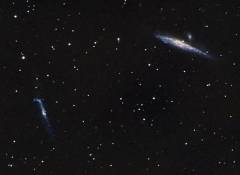
|
This interesting pair of galaxies are known as the Whale (NGC 4631) and the Hockey Stick (NGC 4656) because of their distinctive shapes. These two galaxies are 30 million light years distant in the constellation of Canes Venatici, where there are many other galaxies. In this picture the Whale's small companion NGC 4627 can be seen, and if you know where to look a couple of other faint fuzzies including PGC 42772 are just detectable.
NGC 4631 is a spiral galaxy seen edge-on. To the lower left in this picture is the irregular spiral galaxy NGC 4656, which has been disturbed by gravitational interactions with the larger one. A faint trail can be detected leading away from the curved end of the galaxy, and in fact a "bridge" of hydrogen has been found connecting the two galaxies. The small separate blob off the end of the hockey stick (the puck!) has been given the separate designation of NGC 4657. Click the image to see the full-sized picture | |||||
| The image was captured using my Atik 16HR camera. As usual, the Luminance and colour images were pre-processed separately and combined afterwards using Registax software, then post-processed. |
| |||||
| to top | home | |||||
1 March 2009, Galaxies in Markarian's Chain
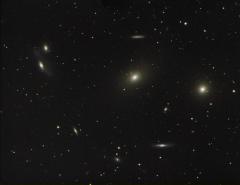
|
This is an image of the southern part of Markarian's Chain in the Virgo Galaxy cluster. There are hundreds or even thousands of galaxies in the Leo, Virgo and Coma area, and Markarian's Chain is a notable area of galaxies strung in a line, although surrounded by many others. This picture shows M86, M84 (the large lenticular galaxies in the centre), NGC 4438 (the irregular galaxy on the left), NGC 4435 (the smaller galaxy paired with 4438), NGC 4402 and NGC 4388 (edge-on spirals above and below M86 respectively), NGC 4425 (on the lower left), and many smaller objects.
Click the image to see the full-sized picture, or Here for a smaller version. | |||||
| The image was captured using my Atik 16HR camera using the LRGB image method over the course of 2 nights. It compares favourably with an image of the same area (although a wider view) below, which was captured in May 2005 using the Canon DSLR. The Luminance and colour images were pre-processed separately and combined afterwards using Registax software, then post-processed. |
| |||||
| to top | home | |||||
27 October 2008, Open Cluster NGC206 in M31
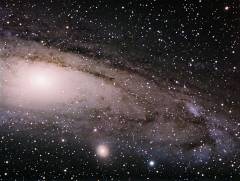
|
This image of the Andromeda Galaxy, M31, shows that only half of it will fit into the field of view of my Atik 16HR when that camera is coupled with the Megrez 80 Apo telescope. However that view does show the open cluster NGC206 nicely. This is a cluster within the 2.5 million light year-distant galaxy, not in our own! You can see it in the image here as a brighter blueish area in the middle of the right-hand side. This LRGB picture was made using luminance and colour images, plus some Hydrogen Alpha captured with the Baader filter to show red emission nebulas within M31. Also in this image is the small eliptical galaxy M32 near the bottom of the picture.
| |||||
| to top | home | |||||
21 October 2008, M33 - the Triangulum Galaxy
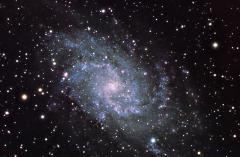
|
M33 is the large galaxy in the constellation of Triangulum. Although it is magnitude 5.7, that total brightness is spread across its whole size and consequently it is rather dim!. M33 is a member of our local group of galaxies about 3 million light years distant, and is a spectacular-looking spiral. | |||||
| This LRGB picture was made using an hour of luminance and half an hour of Hydrogen-alpha data. I used the colour from my image of November last year and added the h-alpha to the red channel. the h-alpha shows up the emission nebulae and star-forming regions within the M33 galaxy. |
| |||||
| to top | home | |||||
30 March 2008, NGC2903 Wide Field
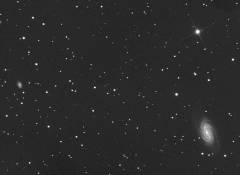
|
NGC2903 is another galaxy in the constellation of Leo. It is a nice spiral located 20.5 million light years away. In the vicinity is also a smaller spiral, NGC2916, shown here on the left of the image. Less obvious are another couple of "faint fuzzies", PGC 0027249 (on the left under NGC 2916) and PGC 27115 (very faint, just left of NGC2903). The bright star is HIP 46804.
| |||||
| to top | home | |||||
30 March 2008, M81 and M82

|
In Ursa Major, near the famous Plough (or big dipper) asterism, can be found two of the brighter and visually appealing galaxies in the Messier list. M81 is known as Bode's galaxy and M82 is also called the Cigar galaxy. The pair are only two members of the M81 group, which is one of the closest galaxy groups to our own Local Group, approximately 12 million light years away.
M81 is a classic face-on spiral, and is bright enough to see with binoculars (I have done so during a total lunar eclipse!) or even with the unaided eye according to some reports. M82 is a more unusual galaxy, classed as irregular - possibly an edge-on disk. M82 has distinctive dark dust lanes that are thought to be the result of an encounter with M81. This encounter has also left an impression in M81. | |||||
|
For this picture I captured luminance and red/green/blue on 12 March, and combined them to make this LRGB image. The image can be seen below. Then on 30 March I captured an hour of Hydrogen alpha and blended it into the red channel. This shows the red gas bursting out from M82, and some small hydrogen regions in M81. |
Image Details:
| |||||
12 March 2008, original image without H-alpha
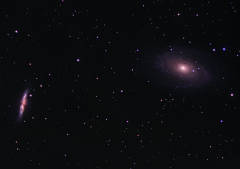
|
||||||
| to top | home | |||||
3-4 March 2008, Leo 1 Galaxy Group
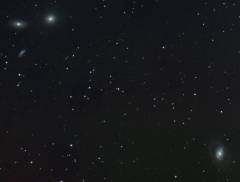
|
The constellation of Leo contains many galaxies. The Leo 1 or M96 group contains several subgroups - this image shows the some galaxies from the M96 subgroup - further divided into a small group containing M105, NGC 3384, and NGC3389 at the top left of the image. and M96 at the bottom-right of the image. M105 is the elliptical galaxy on the right of the group of three. NGC 3384 is the elliptical galaxy on its left, and NGC 3389 is the spiral below that. M96 has a companion, M95, which is not shown in this picture. The galaxies in this image are about 38 million light years distant from Earth.
If you look closely you might notice a couple of very small galaxies in the bottom-left of the image. If you find the 1160 pixel-width image too large, click HERE for a smaller image (900 pixels wide).
| |||||
| to top | home | |||||
16 November 2007, M33 the Triangulum Galaxy
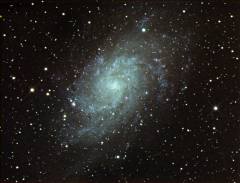
|
Here is another picture of Messier 33, a spiral galaxy in the constellation of Triangulum. Sometimes known as the Pinwheel Galaxy although that name is more commonly given to M101 -- see M101 below.
| |||||
| to top | home | |||||
16 November 2007, The Deer Lick Group and Stefan's Quintet - Galaxy groups in Pegasus
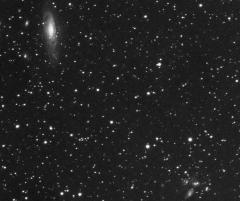
|
NGC7331 is a galaxy in Pegasus. It is a group called the Deer Lick group. Nearby is Stefan's Quintet (see below). Click the image for a large picture and more information. | |||||
| to top | home | |||||
18 October 2007, NGC6946 Spiral Galaxy in Cepheus

|
NGC6946 is an attractive spiral galaxy in the constellation of Cepheus, it is sometimes known as the Fireworks Galaxy because of the large number of supernovae that have been observed there (see HERE for an example). This galaxy is 10 million light years away, which is not far in galactic terms, and lies close to the plane of our galaxy so is rather obscured by dust in the Milky Way. To capture this image I collected around half an hour each of red, green, blue, and luminance images (45 seconds each colour image and 60 seconds for the luminance images) through Astronomik filters with my Vesta SC3 modified webcam in Raw mode. The telescope used was my William Optics Megrez 80 Super Apo. Each set was stacked in K3CCDTools, and the red/green/blue images composed into a single colour image using Registax. The result was postprocessed in PixInsight LE and final luminance layering and processing in The Gimp. | |||||
| to top | home | |||||
12 September 2007, M31 the Andromeda Galaxy
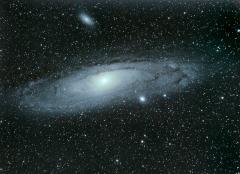
|
Here is another picture of Messier 31, the Andromeda Galaxy. I captured four hours of images over three days for this image.
| |||||
| to top | home | |||||
10 March 2007, NGC 4631 the Whale Galaxy

|
This is an interesting galaxy with lots of details visible. There is a small lenticular galaxy to the North (down on this image) called NGC 4627, and a faint bridge of material joining the two, due to the gravitational effects. To create this picture the Vesta SC3 modified webcam was attached to my C8 telescope with focal reducer, working at F/5.0. I used Astronomik filters to capture separate Luminance (320x10 seconds plus 5x20 seconds) and Red, Green, and Blue images (approx. 100x15 seconds each), which were all processed separately and then combined to produce a final LRGB image. For details of the method see This Page | |||||
| to top | home | |||||
15 February 2007: M66 irregular spiral in Leo

|
This image is another captured with my Vesta SC3 modified webcam attached to the C8 telescope. I used a focal reducer to increase the field of view, which meant that the telescope had an effective focal ratio of f/5 rather than the standard f/10. In all I captured and stacked 70x13 seconds.
The original frames were pre-processed using software called ImageTOOLSca, which was written by my friend Carsten Arnholm. The software is used to extract the AVI frames to FITs format, then calibrate them using dark, flat, and bias frames. After stacking, the image was processed as normal using PixInsight LE, and The Gimp. | |||||
| to top | home | |||||
11 November 2006, M31/32/110 in Andromeda
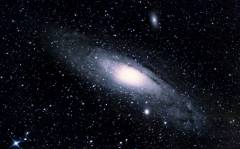
|
Here is another image of M31, the Andromeda Galaxy, together with its two companions M32 and M110. This was captured with the Canon EOS300D camera attached to the Megrez 80 II SD telescope. I captured 48 images of 90 seconds each.
The images were processed with dark frames, then aligned and stacked all in Deep Sky Stacker. The result was postprocessed in PixInsight LE and The Gimp. | |||||
| to top | home | |||||
31 May 2006: M81, Bode's Galaxy

|
On the night of 31 May 2006 I captured this image of M81 with my Vesta SC3 at prime focus of my Megrez 80II SD. The final image is a stack of 118x15-second frames captured in RAW mode, dark-subtracted in iMerge (which does the job better than Registax), stacked in Registax V3, then post processed using PixInsight LE, Iris, and The Gimp.
Although the background is not very flat in this image, I was really surprised by how much PixInsight LE could bring out, considering that the raw files looked rather poor. I will need to revisit this galaxy to improve on this image. | |||||
| to top | home | |||||
3 April 2006: M51, the Whirlpool Galaxy
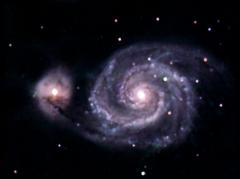
|
After imaging M51 in black and white last month, I decided to return to it to improve the result. Using my Vesta SC3 webcam I captured additional luminance (black and white) data plus some colour to give this result.
To produce this image I stacked 80x18seconds luminance, and merged in the result from 3 March, although this didn't add a lot to the final image. I also captured 50 frames each through red, green, and blue filters, to provide the colour data for the image. The R/G/B images were stacked separately in K3CCDTools then merged into one colour image using Registax 3. The RGB and the Luminance images were processed separately in PixInsight LE, and finally merged into one LRGB colour image using The Gimp. Some noise was reduced using NeatImage. Click the image to see a large (800 pixel wide) version, or click HERE to see the original 640x480 image. | |||||
| to top | home | |||||
22 March 2006: M109 Barred spiral
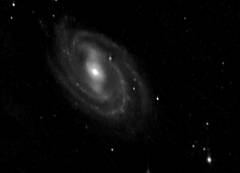
|
M109 is another barred spiral galaxy in the constellation of Ursa Major. The cluster of which it's a member has 79 identified galaxies. Read more about the Ursa Major Cluster here: http://arxiv.org/abs/astro-ph/9608124
On this evening it was rather cloudy and I didn't capture a lot of data. Using the Vesta SC3 webcam I captured 116x20sec frames. I stacked all 116 frames in K3CCDTools, no dark frames used, and post-processed in PixInsight LE, Iris, and The Gimp. | |||||
| to top | home | |||||
3 March 2006: M51, the Whirlpool Galaxy
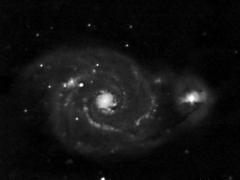
|
M51 is a spectacular galaxy in Canes Venatici, close to the handle of the Plough in Ursa Major. It's known as the Whirlpool Galaxy, for obvious reasons. As you can see it is actually formed of two galaxies - the main one, NGC5194, and the smaller one on the right in this picture, NGC5195. These two galaxies are apparently in the process of merging, but closer analysis reveals that the smaller galaxy is passing behind the large one. This type of galaxy (the large one) with two long spiral arms, is known as a "grand design" type of galaxy.
I captured this image at the end of an evening, and only allowed about 10 minutes. I used the Vesta SC3 webcam with IR-blocking filter, and captured 64x10sec frames. They were then stacked in K3CCDTools, and post-processed using PixInsight LE and The Gimp. | |||||
| to top | home | |||||
3 March 2006: NGC 3953 Barred Spiral Galaxy

|
This is a barred spiral galaxy, NGC3953, which is a neighbour of M109 in Ursa Major. I used my Vesta SC3 webcam with an IR-blocking filter, and set to 100% gain and 68% gamma. I captured 268 good 13-second frames, which I stacked in Registax.
Post processing was in PixInsight LE, and The Gimp, with a small amount of noise reduction in Noiseware Community Edition. | |||||
| to top | home | |||||
1 March 2006: M63, the Sunflower Galaxy
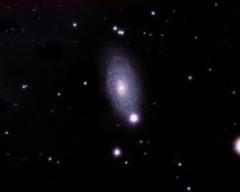
|
Number 63 in Messier's list, M63 is known as the Sunflower Galaxy -- for its shape rather than its colour. M63 is one of a large number of galaxies in the Ursa Major and Canes Venatici area of the sky, including many Messier objects, and many more non-messier objects.
For this picture I used my SC3 camera with, and without coloured filters. First I captured 111x30-second unguided frames with the webcam in black and white raw mode, unfiltered. Gain 81%, gamma 16%. Stacked in K3CCDTools, post-processed in PixInsight LE and The Gimp. Next, I captured around 20x30seconds each through a Red, Green, and Blue filter. The unfiltered and colour AVIs were processed individually and used as Luminance and colour information for this composite image. I also used a new (for me) technique in Iris to remove some high-frequency banding that appears on some of my long-exposure webcam images. | |||||
| to top | home | |||||
28 February 2006: M101 - the Pinwheel Galaxy
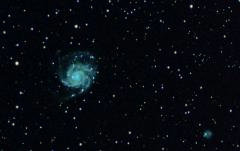
|
M101, also known as the Pinwheel Galaxy, is an attractive face-on spiral galaxy in the constellation of Ursa Major. For this picture I used my Megrez 80 II SD refractor, with the Canon EOS 300D digital SLR camera and an Astronomik CLS filter.
The small "blob" in the lower-right of the image is NGC 5474, another galaxy. For this image I stacked 9 images of approximately 6 minutes each with the camera set to ISO 800. I stacked the images in K3CCDTools and Postprocessed in PixInsight LE and The Gimp. | |||||
| to top | home | |||||
21 February 2006: Spiral galaxy M100 with supernova 2006X
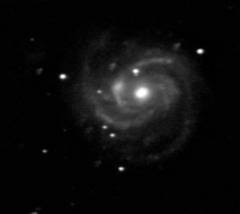
|
Messier 100 is a face-on spiral galaxy in the constellation of Coma Berenices. On 7 February 2006 a supernova was discovered in this galaxy which I managed to capture using my SC3 modified webcam in rather poor conditions on 21 February.
This image is a stack of 65x17 second frames, selected from 140 frames and stacked in K3CCDTools. They were captured using the Vesta SC3 camera in B&W raw mode, at prime focus of my Europa 250 newtonian telescope. in to 86%. The camera gamma was set to 48%, and gain to 89%. The image was processed using PixInsight LE and the Gimp 2.. |
|||||
| to top | home | |||||
20 January 2006: NGC891
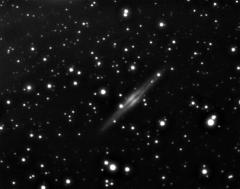
|
This edge-on galaxy is in the constellation of Andromeda. To capture this picture I attached my Vesta SC3 modified webcam to my Megrez 80SD refractor. This image is rather in detail because of the short focal length, the wide field is attractive -- compare with the coloured and higher magnification image from November 2004, below. To eliminate sky glow and chromatic abberation due to the optics of achromatic refractors I shot through a Baader contrast-booster filter. I stacked 199x30sec (out of 250 captured).
The camera was in black and white RAW mode, gamma 32%, gain 86%. I stacked the images using K3CCDTools, post-processed in PixInsight LE and The Gimp. |
|||||
| to top | home | |||||
20 January 2006: M82, the Cigar Galaxy
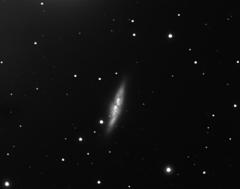
|
M82 forms a distinctive pair in the constellation of Ursa Major with its companion M81 (not in this image). This galaxy is known as the Cigar Galaxy, owing to its shape. It is classified as an "irregular" galaxy due to some detail being seen, but no obvious spiral characteristics. This image is the second of the evening (after NGC891 above). For this image the Vesta SC3 webcam was on my Megrez telescope, using my Baader Contrast-Booster filter to avoid distortion between the colour channels due to the telescope optics, and captured 206x30 seconds frames.
I stacked the images using K3CCDTools, post-processed in PixInsight LE and The Gimp.
|
|||||
| to top | home | |||||
3 November 2005: M33, The Triangulum Galaxy
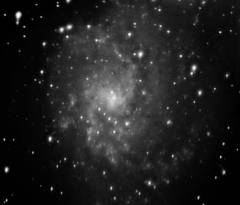
|
Here is another image of this large spiral galaxy in the constellation of Triangulum. This time captured using the SC3 modified webcam, it shows more detail than the previous image (captured using the Canon EOS300D) but is only black and white, and has a smaller field of view. For this image I stacked 121x25 seconds, using K3CCDTools. The webcam was in black and white raw mode with gamma=32%, gain=71%. Post processing was done using PixInsight LE. |
|||||
| to top | home | |||||
4 October 2005: Stephan's Quintet Galaxy Group
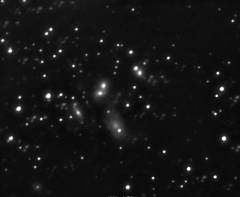
|
This cluster in the vicinity of larger galaxy NGC7331 (See below) comprises NGC7317, 7318A, 7318B, 7319, and 7320. In this picture NGC7320C is also visible to the lower left. Measurements suggest that NGC7320C is much closer than the others, and is therefore a chance foreground object, not part of the cluster.
The members of this cluster are rather small and faint, and therefore hard to see in the telescope eyepiece. However its closeness to NGC7331 means that the larger galaxy can be used as a pointer to locating the small group. This image is a stack of about 70x40 second frames, stacked in K3CCDTools. They were captured using the Vesta SC3 camera in B&W raw mode, at prime focus of my Europa 250 newtonian telescope, with a Baader UV-IR blocker. Gamma was set to 26%, and gain to 86%. About 15 frames were captured using an Astronomik CLS light-pollution filter, for which the gamma was increased to 68%. The image was processed using PixInsight LE, the Gimp 2, and Iris. |
|||||
| to top | home | |||||
2 October 2005: M33, The Triangulum Galaxy

|
This is a picture of M33, a large galaxy in the constellation of Triangulum. This is only a single frame of 331 seconds duration captured at the end of the evening with the Canon EOS300D in Raw mode, at prime focus of my ST80 refractor. The camera was set to ISO1600. Although has a fairly bright absolute magnitude, this brightness is spread across a large size so in reality it's rather dim and hard to image well, especially with a DSLR camera like this. |
|||||
| to top | home | |||||
2 October 2005: M31, The Andromeda Galaxy
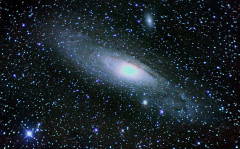
|
This is another picture of M31, this time with 6 times as much exposure as the picture below. Like that image, it was captured with the Canon EOS300D in Raw mode, at prime focus of the ST80 refractor. The camera was set to ISO800. The improvement from using six five-minute exposures rather than a single one is clear. Not only is the galaxy brighter and clearer, but there is less "noise" in the image. The six images were stacked in K3CCDTools, and then as before, I processed it using Pleiades PixInsight LE and The Gimp. |
|||||
| to top | home | |||||
7 August 2005: M31, The Andromeda Galaxy, with companions M32 and M110

|
This image shows the great Andromeda Galaxy, our nearest galactic neighbour at around 3 million light years away. The small elongated galaxy at the top of the picture is M110, and the smaller fuzzy spot between stars to the lower right of the large galaxy is M32. Both are companions to M31 and are eliptical galaxies (as opposed to M31's spiral shape).
I captured this image at the end of an evening after imaging some other objects. This is a single 5-minute exposure captured in Raw mode with the Canon EOS300D camera at prime focus of my 80mm f/5 achromatic refractor. The image was converted to a TIFF file using Canon's image viewer software and processed using Pleiades PixInsight LE and The Gimp. |
|||||
| to top | home | |||||
13 July 2005: M51, The Whirlpool Galaxy, with Supernova 2005cs

|
For this picture I attached my EOS300D DSLR to the ST80 400mm f/5 refractor. This gave me a fairly wide field of M51.
This image is a stack of 14x1minute exposures, captured at ISO 400. It's an improvement over my last image of the galaxy (below, with the SC1 webcam), and shows a supernova designated 2005cs that appeared in June 2005. Click the top picture on the left to see the full picture |
|||||
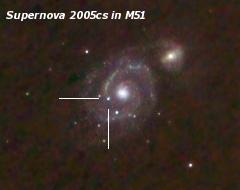
|
||||||
| to top | home | |||||
10 May 2005: The Virgo galaxy cluster

|
The constellation of Virgo contains a cluster of hundreds of galaxies. I used my Canon DSLR attached to the ST80 wide-field refractor to capture an image showing almost 30 galaxies including the Messier objects M84, M86, M87, and M88.
The line of galaxies crossing the picture approximately from bottom-left to top-right is known as Markarian's Chain. |
|||||
| to top | home | |||||
April 2005: The Leo Triplet of galaxies

|
The constellation of Leo holds contains many galaxies, some in small clusters or groups like the so-called Leo Triplet pictured on 35mm film here. Click the picture for more information.
|
|||||
| to top | home | |||||
5 March, 2005: M51, the Whirlpool Galaxy
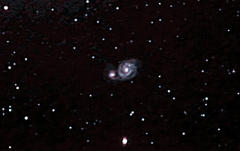
|
A glance at any picture of Messier object 51 shows why it's known as the Whirlpool Galaxy. Its shape is that of the classic spiral galaxy. This one is more interesting in that it has a small companion joined to the main galaxy. The companion is called NGC 5195. This picture was captured using my QC3000 SC1 webcam, with a 135mm SLR lens attached. The camera was in "non-raw optimized colour" mode, a special macro designed to get optimum results without resorting to raw mode. I would have liked more frames but ended up with: 75x30 seconds, 15x45 seconds, and 5x60 seconds. I stacked them in K3CCDTools and processed the picture in The Gimp 2 and NeatImage (for noise reduction). The colour balance on the webcam turned out to be set in such a way that no blue was captured. So I used a copy of the composite image, turned to greyscale, as the blue channel. |
|||||
| to top | home | |||||
14 November 2004: NGC 891
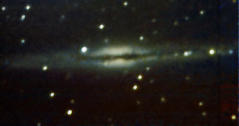
|
NGC 891 is an edge-on spiral galaxy in the
constellation of Andromeda. It has a promenant dust
lane visible along its edge. Like most galaxies,
this is a faint object and clear details are
difficult with an SC1 webcam.
This image was formed by combining three stacks, of 100x45 seconds, 32x40 seconds and finally 3x60 seconds in The Gimp. Each was captured at prime focus with the QC3000 SC1.5. The brighter stars were reduced a little using the "dilate" filter in The Gimp. |
|||||
| to top | home | |||||
4 October 2004: NGC 7331 and NGC 7335
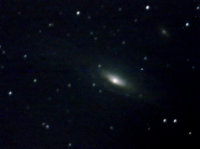
|
Another attempt at this spiral galaxy, which turns out to be quite difficult for a webcam, even a modified one! I played for ages with the processing. I've been trying Pleiades PixInsightLE, Image Analyzer, as well as my usual Gimp and Neat Image. In the end the sequence was: K3CCDTools->Gimp->Image Analyzer (for noise reduction)->Gimp->NeatImage (more noise reduction)->Gimp (again) I used my QC3000 SC1.5, 216mm f/5 Newtonian and captured 79 frames in colour raw mode, a mixture of 40 and 45 seconds each, of which I stacked around 50. | |||||
2 October 2004: Supernova in NGC 6946

|
NGC 6946 is a rather faint galaxy, at least for webcam imaging, but for a few months one star outshone many in our own milky way. A star in the distant galaxy exploded in a supernova and I captured an image of it. Click the picture for more details. |
|||||
| to top | home | |||||
13 September 2004: The Andromeda Galaxy

|
This attempt on Messier object 31 was taken with a 135mm SLR lens, rather than through the telescope. This meant much more of the galaxy fitted into the field of view. This image is composed of 80x40sec and 50x15sec stacked in K3CCDTools and shows M32, the smaller galaxy associated with M31, at the top of the picture. | |||||
| to top | home | |||||
10 September 2004: NGC 7331 and NGC 7335
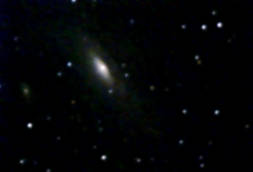
|
NGC 7331 is a spiral galaxy in Pegasus. It is fairly easy to find but not easy to get good results with a webcam, as this picture shows. It has several galaxies close by, of which I have captured one, NGC 7335, in this picture.
Exposures were 38x25 seconds, QC3000 SC1.5 Colour Raw mode, Debayered in AVIRaw, Dark subtracted in iPrep. Stacked in Registax, processed with the Gimp and NeatImage. There's a little diagonal noise remaining, which I tried to blur out but that made the overall look worse. So I've left it in. |
|||||
| to top | home | |||||
3 September 2004: Messier 31 - The Andromeda Galaxy

|
The Andromeda Galaxy is a companion galaxy to our own milky way. It is visible with the naked eye, and at around 3 million light years away is the furthest object that can be seen unaided. The galaxy is very large and will not fit in a single webcam field of view. This image shows only the core of the galaxy with some dust lane detail visible. This picture was taken with the QC3000SC1.5 in Raw mode. I was trying out differing exposure times, so this one is composed of 10x40sec,4x50sec,5x60sec,1x70sec,3x90sec stacked in K3CCDTools then post-processed in the Gimp.> | |||||
| to top | home | |||||
 |
||||||
| All text and images copyright and may not be used without permission |
||||||